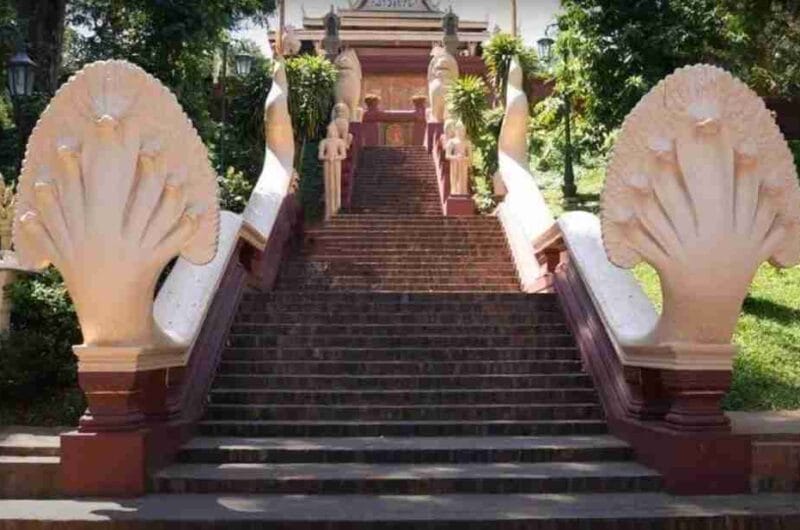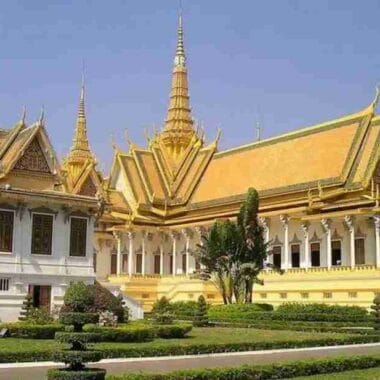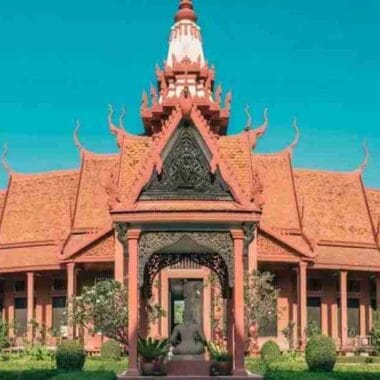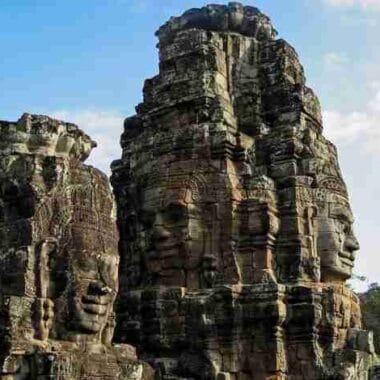Wat Phnom or Hill of Grandma Penh is the most significant Buddhist temple of all the temples located in Phnom Penh. It was built in 1372, and stands 27 metres above the ground. It is the tallest religious structure in the city and it is the central point of Phnom Penh. It locates in a large traffic circle at the north end of Norodom Boulevard. The complex is oriented toward the east, where a broad staircase, flanked by nagas, guardians and lion-like figures, leads directly to the vihara.
The sanctuary itself was renovated several times, in 1434, 1806, 1894, and 1926, which each year of renovating was made the sanctuary looks better. The interior of the temple has a large bronze seated Buddha surrounded by other statues, flowers, candles and items of devotion and worship. The walls are covered with murals, especially the stories of the Buddha and the Reamker, the Khmer version of the Ramayana. It is only a Buddist temple that have no monks stay permanently at the hill temple.
There is a prominent stupa immediately west of the sanctuary contains the ashes of the king and his royal family which still lies in his stupa, at peace. The stupa itself has been renovated frequently.
The southwest corner of the temple and stupa, is a small shrine dedicated to Lady Penh. The front is often crowded with the faithful bringing their prayers and food offerings to the woman deemed responsible for the founding of the Wat. On the other side of the hill, a giant clock faces down Norodom Boulevar.
The statue of King Sisowath
The statue of King Sisowath which is located at the southern downhill of Wat Phnom. The statue was built as a symbol of deliverance the territorial integrity of Siem Reap, Battambang, and Serei Sophorn to be under the rule of the King Khmer in 1907, after Stung Treng, Mlo Prey, and Tonle Pov returned to Cambodia in 1904. But the statue as seen today is not the original statue, it has just been copied from the original in 1998. The copied statue is built from cement, while the original was made of most of copper-based metals in 1909 and now it is stored at the National Museum.

Today, Wat Phnom is an astonishing reflection of its own and Cambodia’s diverse history. To the left of the main altar, there is an image of the Hindu god, Vishnu. On the hill just below the pagoda sits a Chinese temple dedicated to the Hainan deity, Bentougong. A shrine dedicated to Preah Chau is popular among the city’s Vietnamese community.
Nowadays, Wat Phnom is openly for the public both local and foreigner. Wat Phnom has become a central attraction in the city and is a must visit when in Phnom Penh, especially it is the center of celebration during International New Year, Khmer New Year and Pchum Ben festival.
Wat Phnom Hours and Admission Fees
- The temple is open every day from dawn to dusk.
- There’s a US$1 fee for foreigners to visit the top of the hill. There’s a ticket booth at the base of the eastern stairs, or a guard can collect the money at the top.
- Around the northwest side of the hill is a small museum. The mostly diarama displays are a bit rudimentary, but there are some interesting photographs on the second floor from the Khmer Rouge era. Admission to the museum is US$2.
- No hats allow when in the holy temple
- Limited photography in certain area.
History of Wat Phnom
The first legend relates that a wealthy widow called Penh (commonly referred to as Daun Penh meaning Grandmother Penh in Khmer) found a large koki tree washed up on the banks of the Tonle Sap in 1372. She intended to use the tree to build a house then she noticed four bronze Buddha in its trunk. After retrieving theses statues, she constructed a small shrine on an artificial hill near her home. Eventually the hill became a sacred site and sanctuary where people would make blessings and pray. In 1372 A.D., Grandma Penh and her neighbors all agreed to build a temple with a thatch roof on top of the hill to house four Buddha statues.

Then it came to the year of the snake 1437 suggests King Ponhea Yat ordered His Excellency to raise the mount even higher. When the king finished building his new Royal Palace in the new city then named Krong Chaktomok Mongkol or simply known as Phnom Penh. Phnom Penh became Cambodia’s capital in 1434 for a first time After King Ponhea Yat had to flee from Siamese invaders attacking Angkor in 1432. He also had founded the Royal Palace and five monasteries, namely Wat Phnom, Wat Botum, Wat Koh, Wat Lanka and Wat Ounalom, all of which survive today.
The pagoda at the top of the hill was destroyed by a fire in 1881, the tasks to refurbish the pagoda and surround area with gardens in the early 1890s. The new stairway leading directly to the pagoda also added. The Naga Bridge originally traversed a 3,100-metre long canal at the southern of Hill was filled in and turned into a park in the 1930s.










